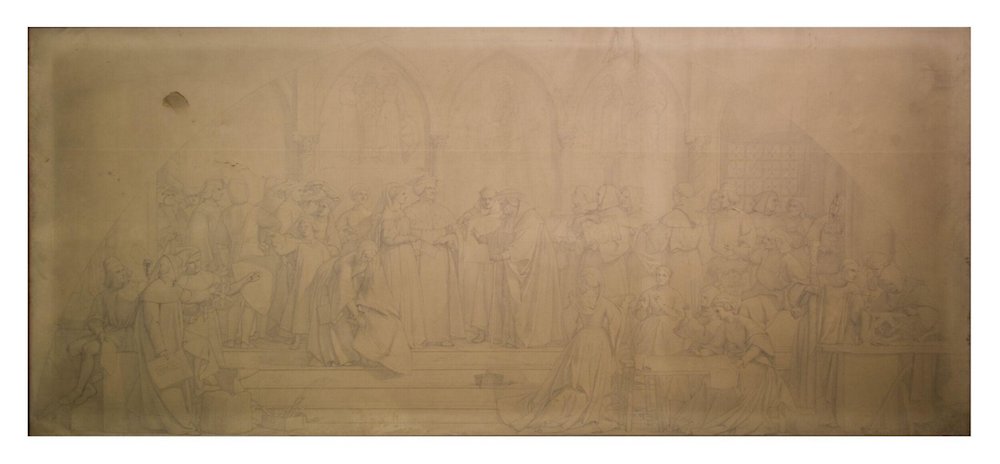
Design for a fresco lunette, The Industrial Arts in Time of Peace by Frederick Richard Pickersgill (1820-1900). 1871–1872. Oil on canvas. H 108.3 x W 244.2 cm. Accession no. 127-1885. Commissioned for the South Kensington Museum (Victoria and Albert Museum) in 1871. The design shown here is the culmination of a process: two earlier stages, in watercolour and crayon, are shown below. [Click on all the images to enlarge them.]

The design for the lunette, c.1871, in pencil, pen and watercolour on paper. 7 ¾ x 17 ¾ inches (19.5 x 45 cm). Scott Thomas Buckle Collection.

Drawing for the lunette. c.1871-72. Crayon on paper. Height: 196.9cm x Width: 457.2cm (6 1/2ft x 15ft). Collection: Victoria and Albert Museum, accession no. 128-1885.
This work was commissioned for the (then) South Kensington Museum's South Court, and it shows an aristocratic couple and their retinue looking on, as clerics (including monks) reveal their handiwork. Men and women on the lower level, in the foreground, are actively engaged in the various arts. On the left here are artisans with their tools, towards the right are women with embroidery or other decorative accoutrements, and on the far right is a small group of woodworkers. The various costumes are medieval, and the setting ecclesiastical, reminding us of the great source of inspiration for the arts in times past. — Jacqueline Banerjee
Commentary by Scott Thomas Buckle
In the 1860s, a number of schemes were explored to decorate the four large lunettes in the South Court of the South Kensington Museum, now the Victoria and Albert Museum. G.F. Watts produced a sketch for a mosaic to fill one lunette, whilst other artists were invited to make designs for another. By 1868, the plan had changed to execute frescoes instead, with Frederic Leighton and Watts as the chosen artists, although Watts' fresco was never realised. In 1871 Frederick Richard Pickergill was commissioned to design the decoration for a third lunette, and chose for his subject The Industrial Arts in Time of Peace. He was paid £500 for his design in oil, but shortage of funds prevented the work from being executed in mosaic. The sketch for the composition shows a cardinal at the centre gesturing towards an arched fresco of the Madonna and child. He engages with a nobleman and his wife, their retinue behind them to the left, whilst the cardinal is flanked by a group of monks to the right. In the foreground are groups of figures engaged in different arts. Pickersgill's sketch is compositionally similar to the more finished oil design, although there are several differences between each version. The frescoes within the arches at the back of the composition are different in the sketch; the poses of several figures are altered, whilst some figures only appear in the oil version. Even so, the sketch shows that the artist had a clear idea of what he aimed to achieve in both colour and composition at an early stage of the commission. Although Pickersgill's design was never fully realised, Leighton eventually produced a second fresco upon a similar theme, Industrial Arts as Applied to Peace, which along with his Industrial Arts as Applied to War, remains in situ to this day.
Link to Related Material
Information about the watercolour version provided by Dennis T. Lanigan — this image is reproduced here courtesy of the Scott Thomas Buckle Collection, for purposes of a review of Victorian Treasures from the Cecil French Bequest and Scott Thomas Buckle Collection (24 May-21 September 2025). The Victoria and Albert images are included here for purposes of non-commercial academic research.
Bibliography
The Industrial Arts in Time of Peace (oil painting). Victoria and Albert Museum. Web. 3 June 2025.
The Industrial Arts in Time of Peace (crayon drawing). Victoria and Albert Museum. Web. 3 June 2025.
Ormond, Richard. Leighton's Frescoes in the Victoria and Albert Museum. London: Victoria and Albert Museum, 1975. 2.
Physick, John. The Victoria and Albert Museum – The history of its building. Oxford: Phaidon - Christie's, 1982. 71-79.
Vialla, Jean. Les Pickersgill-Arundale, une famille de peintres anglais au XIXe siècle. Paris: M.L.I., 1983. 173.
Willsdon, Clare A.P. Mural Painting in Britain, 1840-1940, Image and Meaning. Oxford: Oxford University Press, 2000. 268 (n. 54).
Created 3 June 2025